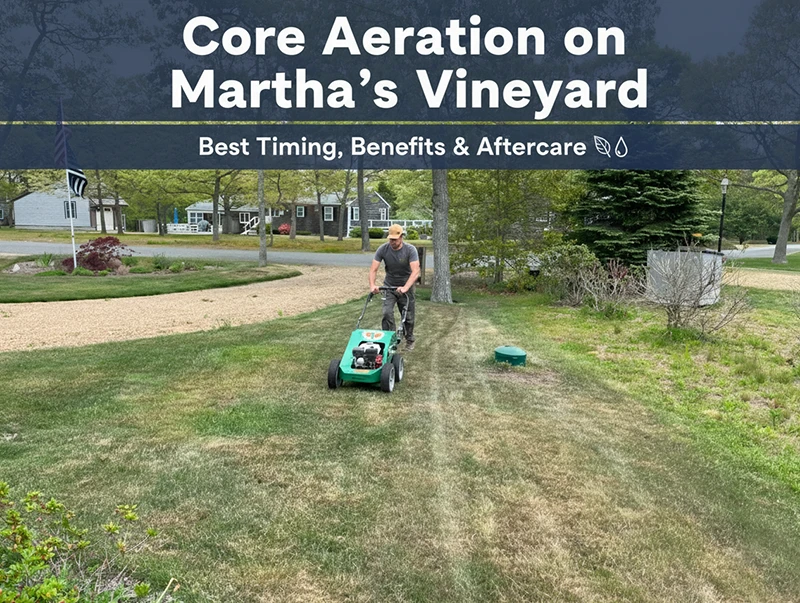Summary (TL;DR)
On Martha’s Vineyard, the best time to core-aerate cool-season lawns is early fall (mid-September to mid-October), with a secondary window in spring (April) if the turf is compacted. Aeration relieves compaction from summer traffic, improves water infiltration on our sandy/loamy island soils, reduces thatch, and boosts seed germination. For best results, pair aeration with overseeding, light compost topdressing, and a simple 3–4 week aftercare plan (watering, high-cut mowing, no herbicides). Book your visit with our team for a smooth, mess-free service and a visibly healthier lawn.
Why Core Aeration Matters on the Island
MV lawns take a beating: heavy foot traffic in summer, compacted topsoil around new builds, salt air, and stretches of dry weather. Core aeration (also called plug aeration) uses hollow tines to pull out small soil cores, opening channels for air, water, and nutrients to reach the root zone. Unlike “spiking,” removing cores actually creates lasting space so roots can expand.
Hallmark benefits
- Looser soil + deeper roots: Roots can explore 2–4× deeper over the season.
- Better water absorption: Rain and irrigation travel into the profile instead of running off or puddling.
- Less thatch accumulation: Microbes get oxygen and break down thatch naturally.
- Stronger, thicker turf: Especially when combined with overseeding and organic nutrition.
- Fewer weeds over time: Dense turf shades out invaders like crabgrass.
Best Timing on Martha’s Vineyard
For cool-season grasses common here (turf-type tall fescue, fine fescue, Kentucky bluegrass, perennial ryegrass), target:
- Primary window: Mid-September to mid-October. Soils are warm, nights are cool, and fall moisture supports recovery and new seedling growth.
- Secondary window: April. Useful when summer compaction was severe or if you missed fall. Avoid aerating during summer heat or drought stress.
- Soil moisture check: Ideal when soil is moist but not soggy—after rainfall or gentle irrigation.
If you want a turn-key plan (aeration + overseed + compost topdress), book our Core Aeration Service and we’ll handle everything in one visit.
Signs Your MV Lawn Needs Aeration
- The soil feels hard underfoot, and a screwdriver won’t push in easily.
- Water pools or runs off instead of soaking in.
- Thatch layer >½ inch.
- Turf looks thin or struggles to green up evenly.
- Heavy summer foot traffic from guests, pets, or events.
What We Do During a Professional Visit
- Site prep & utility marking: We flag irrigation heads and shallow lines.
- Deep, dense coring: 2–3″ core depth, with tight passes to reach ~12–24 holes per sq. ft.
- (Recommended) Overseeding: We seed with island-appropriate blends to fill gaps fast.
- (Recommended) Compost topdressing: A ~¼” layer improves microbial life and seed-to-soil contact.
- Organic fertilization option: Pair with our Lawn Fertilization Services for balanced, slow-release nutrition.
- Weed strategy: If weeds are a concern, we’ll time aeration/overseeding to complement Lawn Weed Control, since some pre-emergents can interfere with new seed.
Looking for a full refresh? Explore our Lawn Restoration Service to combine cleanup, aeration, overseeding, and nutrition in a single plan.
Aftercare: 3–4 Weeks to Lock in Results
1) Watering
- If overseeded: keep the top ½” of soil consistently moist for 14–21 days. Light daily watering (morning) is ideal—adjust for rain.
- Without seeding: resume a deep, infrequent schedule (about 1″ per week total from rain + irrigation).
- Always follow any town watering guidance.
2) Mowing
- First mow after overseeding when new seedlings reach 3–3.5″.
- Maintain a high cut (3–3.5″). Sharp blades only.
3) Traffic
- Minimize heavy traffic (kids, pets, events) for 2–3 weeks, especially on newly seeded areas.
4) Fertility
- If seeding, use a starter-appropriate product or organic alternative based on a soil test.
- Continue with a tailored plan via our Lawn Fertilization Services.
5) Weed Control
- Avoid pre-emergent herbicides before/after seeding unless we schedule them around your overseed window.
- Post-emergent spot treatments can resume after seedlings are established (typically 4–6 weeks).
6) Leave the cores
- Let pulled plugs break down naturally over 1–2 weeks; they return organic matter and microorganisms to the surface.
Who Benefits Most?
- Seasonal homeowners needing dependable fall recovery after a busy summer.
- High-traffic properties (events, dogs, active kids).
- New builds with compacted topsoil.
- Irrigated lawns that still show dry spots or runoff.
Get a Free Island-Local Estimate
Ready to breathe life back into your lawn? Request a free estimate or call +1 508-560-8186. We serve Oak Bluffs, Edgartown, Vineyard Haven, West Tisbury, Chilmark, and Aquinnah.
FAQs (Core Aeration on Martha’s Vineyard)
1) How often should I aerate?
Most MV lawns do well with once per year in fall; high-traffic or compacted sites may need spring touch-ups too.
2) Can I combine aeration with overseeding?
Yes—it’s the best practice. The holes create perfect seed-to-soil contact, improving germination and thickening your turf.
3) Will aeration make a mess?
You’ll see small soil plugs on the surface. They break down in 1–2 weeks and are safe for kids and pets.
4) What if I have irrigation?
We mark heads/valves before we start and adjust depth to protect your system.
5) Do I need compost topdressing?
Highly recommended here. A ¼” compost layer boosts microbes, speeds plug breakdown, and feeds seedlings.
6) When will I see results?
Recovery starts within 1–2 weeks, with visible thickening in 3–6 weeks if you overseed and follow aftercare.


